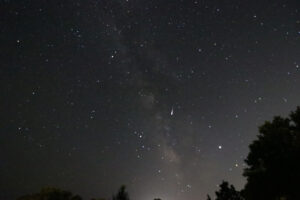You live in the Milky Way galaxy. It’s home base. It’s where almost everything you can see with your naked eye lives, too. Some people can see the Andromeda galaxy, and if you live in the Southern Hemisphere, you can see two small galaxies (the LMC and SMC) that orbit the Milky Way. But other than those three things (and maybe three others, if you have really awesome eyesight and really dark skies) everything you see – in daylight or at night – is in the Milky Way.
There’s about 100,000,000,000 stars in the Milky Way. There may be more; there may be less. It’s hard to count them actually. In the same way that you can’t easily count all the cars on the road if you’re one of the cars on the road. Now, if you could fly over the road in a helicopter, it’s much easier. But we can’t “fly over the Milky Way” in a spacecopter very easily (yet), so we rely on observations of other galaxies to infer information about our own.
This image is one taken near Orleans, Massachusetts, looking south towards the “elbow” of Cape Cod. The sky glow in the distance is caused by the Chatham Lighthouse sweeping out an arc of light every 10 seconds. This exposure was 30 seconds long, so three such sweeps helped illuminate the lower border of the image. And, as luck would have it (because you can never actually plan for this) a short-lived meteor was caught almost dead-center in the image!

